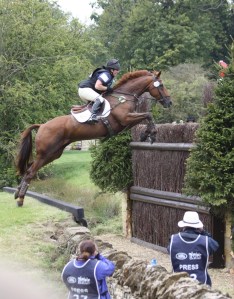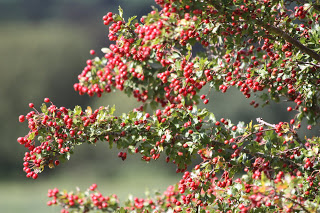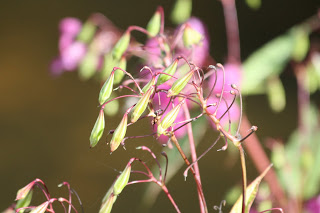When I wrote my initial post on the ancient hedgerow that leads uphill out of the secret valley I intended to update it on a monthly basis (click here). What a failed idea that has proved to be! For March 10th was as hot a day as any summer’s and that, coupled with a very dry winter, created the worst drought for many years. The day that I had intended to walk the hedge (and also the day that a hose pipe ban was announced) the heavens opened and we have had torrential rain ever since. I have been soaked to the skin most days because of work – I had no intention of a second soaking whilst carrying out hedge surveying upon my return home.
A break in the clouds, however, allowed me to sprint up the lane snapping away with the camera moments before the next deluge. No time to marvel at the way nature responds to climate or to look carefully to see what species of plants might be new to my eyes. The only wildlife I saw was a solitary snail, pale lemon in colour and rather pretty – if you can describe a snail as such – which dropped off it’s grass blade perch the moment I got the camera in focus. I’m sure I heard it giggling in the undergrowth.
Here is what I did see.

Cowslips
Cowslips (Primula veris) are a great favourite of mine bringing back memories of early school for ours had a play area that was carpeted with them. Years ago no-one worried about picking great bunches of them or digging some up for the garden which we all did yet the numbers there didn’t seem to diminish. However, overpicking (or perhaps spraying roadside verges) meant that the cowslip became a scarce plant. Happily, they are now seen sporadically along the Cotswold lanes although not on my old school playground which became a high density housing estate in the ’80’s. Along our hedge, cowslips appear in small numbers which, hopefully, will increase over the years. Further up the valley a field grazed only by sheep and never sprayed is a yellow carpet at this time of year and on warm, still days, the faint smell of honey wafts around transporting me back more years than I care to admit to.
Cowslip meadow in the secret valley
Primroses
The last few primroses are still in bloom, quite late for this time of year and no doubt, like some of the daffodils, lasting longer because of the cool, damp weather. Primula vulgaris, their botanical name, sounds like a misnomer for their is nothing vulgar about them, for every part of a primrose is pretty, whether it is the palest lemon of their petals, the deeper yellow throat or the fresh green of their leaves. Even the ribbing and lines of their veins create attractive patternss and textures. Vulgaris does, of course, mean common – there is nothing common about them in appearance either!

The hot March had an odd effect on plants. Some revelled in it, throwing caution to the wind and paraded their summer finery early, whereas others seemed to remember the old saying about not casting a clout ’til May is out. Proven right, when cold returned in April, they now seem reluctant to even expose a leaf and, as a result, the hedgerow is bright green in places, yet bare and wintry looking in others.
Field Maple
Field Maple is a classic old hedgerow plant. Left to grow untouched it makes a medium sized tree of, to my mind, simple but great beauty. However, it is usually trimmed to make a reasonably dense, twiggy barrier. Like all maples the flowers and leaves emerge together but I had never noticed before the rich mahogany colour of the leaf buds. Acer campestre.
Ground Ivy
A plant so common and so small as to be overlooked, Ground Ivy (not related to ivy but to mint)has to be viewed on hands and knees to see its quiet beauty: tiny, mauve, hooded trumpets darkening at the throat. According to my old herbals it was used for all sorts of ailments from the uterus to inflamed eyes and everything in between. Glechoma hederacea, in a greyish variegated form is often used in hanging baskets where it is seen trailing in ugly, thick ribbons. Leave it where it belongs – trailing over the ground at the foot of a hedgerow. Perhaps it should be used in the garden in this way?

Jack-by-the-Hedge
Jack-by-the-Hedge or Garlic Mustard is a common plant and quite a useful addition to early spring salads for its shredded leaves have a mild garlic taste. In the photo above it grows along with stinging nettles and the fine leaves of Cleavers or Goose-grass. It is the food plant of the Orange Tip Butterfly which is quite regularly seen throughout the secret valley, although scarce so far this spring due to weather conditions. Occasionally they fly into the house and require rescuing – not always as easy as in this photo!
Orange Tip Butterfly – only the male is coloured orange
Bluebells with White Dead-Nettle
Bluebells, Hyacinthoides non-scriptus, are another of the ancient woodland indicators (click here for more details of this term) and they flower the whole length of the hedgerow. In the Chiltern Hills, the area where I spent most of my life, the beechwoods are renowned for their Bluebell carpets (photo below). Here, they grow more sparsely, with the occasional white flowered sport growing amongst them. In the photo above, it is the white flowered dead-nettle they mingle with. The dead-nettle, Lamium album, is not related to the true nettle and has no sting, just an unpleasant smell when the leaves are crushed. In the garden it is a nuisance with a white, running root, quite thick and brittle unlike the stinging nettle’s yellow, fibrous root system – a useful way to tell them apart if uncertain, apart from the sting, of course.
A bluebell wood in the Chiltern Hills in Spring
Burdock leaves
The large leaves of Burdock, Arctium minus, are already forming rosettes. It will be a while before they send up their spikes of lilac flowers, reminiscent of those of the thistle and even longer before the troublesome round seedheads, the burs, stick to clothing and She-dog.
The secret valley in flood
It was at this point that the heavens opened once again giving me just time to take a snap of the little winding river. It’s clear, sparkling waters have been transformed by rain to a swirling, brown muddy spate that has now burst its banks spreading out across the valley.




































































 In part 1 of these posts on the Trials – click
In part 1 of these posts on the Trials – click 


 The water jumps always attract the crowds and there is nothing more they like to see than a rider get a good ducking! This year their were few such moments. Apart from small ponds to jump in and out of, the Capability Brown lake also featured as an obstacle. There can be few more magnificent views than this with Burghley House, one of the greatest Elizabethan buildings in England, in the distance.
The water jumps always attract the crowds and there is nothing more they like to see than a rider get a good ducking! This year their were few such moments. Apart from small ponds to jump in and out of, the Capability Brown lake also featured as an obstacle. There can be few more magnificent views than this with Burghley House, one of the greatest Elizabethan buildings in England, in the distance.



 Zara Phillips, daughter of the Princess Royal and grand-daughter of the Queen was another competitor here. She came in tenth place on High Kingdom.
Zara Phillips, daughter of the Princess Royal and grand-daughter of the Queen was another competitor here. She came in tenth place on High Kingdom.










 .
.